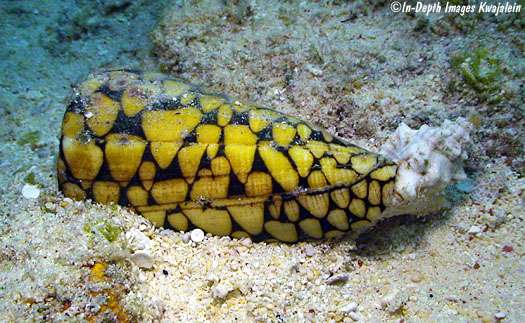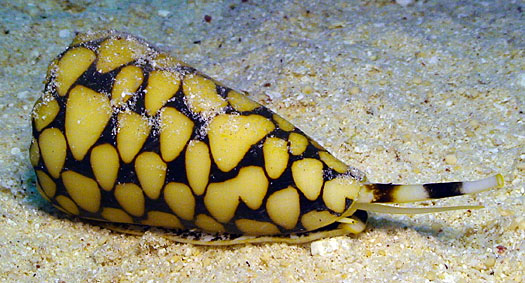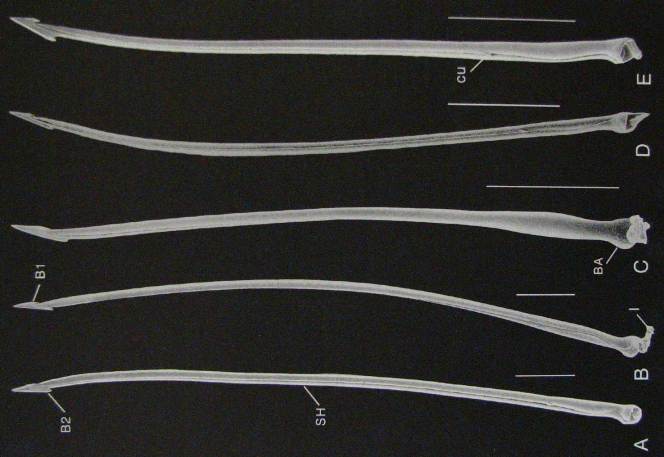Adaptations
 The marbled cone snail, like all members of the Conus
genus, has adapted a very sensitive and flexible siphon, which
has chemoreceptors lining the inside to detect the presence of
their prey. Studies have shown that a cone snail in an aquarium
will exhibit predatory responses (such as burrowing under
substrate with only siphon sticking out) as soon as a prey item
is introduced into the aquarium. A cone snail may even do this
if water that a prey item has recently been in is added to the
aquarium. In the photo below, you can see the snail's
black and white siphon above its proboscis.
The marbled cone snail, like all members of the Conus
genus, has adapted a very sensitive and flexible siphon, which
has chemoreceptors lining the inside to detect the presence of
their prey. Studies have shown that a cone snail in an aquarium
will exhibit predatory responses (such as burrowing under
substrate with only siphon sticking out) as soon as a prey item
is introduced into the aquarium. A cone snail may even do this
if water that a prey item has recently been in is added to the
aquarium. In the photo below, you can see the snail's
black and white siphon above its proboscis.
 Since cone snails are not known for their speed or strength, yet
are still carnivorous predators, they had to adapt an efficient
and fast-working venom. More on these venoms can be found in
the Venom Facts portion of this webpage.
Another example of a venomous animal is the
Southern Pygmy
Rattlesnake. The venom found in cone snails is used
with a modified radular tooth. Members of the Gastropod class
are known for their radula, a tongue-like organ which functions
similar to a conveyor belt by scraping food off the substrate
with its rows of teeth and bringing it to the snail’s mouth.
This radula is modified in carnivorous snail species, as shown
below. Radular
teeth of the Conus genus are long, barbed, and harpoon-shaped,
as is also seen in
Conus magus, another cone
snail. They lie in a quiver-like region in the base of the
proboscis. The poison is stored in and secreted by a poison
duct, which is longer than the shell of the animal itself. To
find out how the siphon and harpoon are utilized in capturing
prey, visit the Nutrition page.
Since cone snails are not known for their speed or strength, yet
are still carnivorous predators, they had to adapt an efficient
and fast-working venom. More on these venoms can be found in
the Venom Facts portion of this webpage.
Another example of a venomous animal is the
Southern Pygmy
Rattlesnake. The venom found in cone snails is used
with a modified radular tooth. Members of the Gastropod class
are known for their radula, a tongue-like organ which functions
similar to a conveyor belt by scraping food off the substrate
with its rows of teeth and bringing it to the snail’s mouth.
This radula is modified in carnivorous snail species, as shown
below. Radular
teeth of the Conus genus are long, barbed, and harpoon-shaped,
as is also seen in
Conus magus, another cone
snail. They lie in a quiver-like region in the base of the
proboscis. The poison is stored in and secreted by a poison
duct, which is longer than the shell of the animal itself. To
find out how the siphon and harpoon are utilized in capturing
prey, visit the Nutrition page.

Another adaptation by the marbled cone snail is something called
torsion, which all members of the Gastropods have undergone.
Mollusk bodies are separated into three parts: head-foot,
mantle, and visceral mass. Torsion is a 180 degree twist in the
body components relative to the head-foot. While this means the
snail takes in food in the same area it excretes waste, it also
allows for better ventilation of gills, as well as enabling the
snail to withdraw its head into its shell quicker.
Continue to Nutrition
Return to Home
Visit MultipleOrganisms.net
Visit the UW-La
Crosse Website
Contact Information